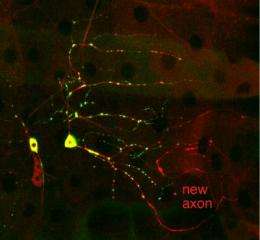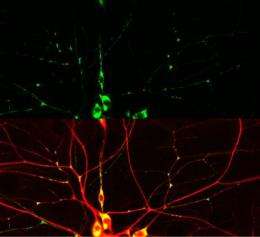Key protein discovered that allows nerve cells to repair themselves

A team of scientists led by Melissa Rolls, an assistant professor of biochemistry and molecular biology at Penn State University, has peered inside neurons to discover an unexpected process that is required for regeneration after severe neuron injury. The process was discovered during Rolls's studies aimed at deciphering the inner workings of dendrites -- the part of the neuron that receives information from other cells and from the outside world. The research will be published in the print edition of the scientific journal Current Biology on 21 December 2010.
"We already know a lot about axons -- the part of the nerve cell that is responsible for sending signals," Rolls said. "However, dendrites -- the receiving end of nerve cells -- have always been quite mysterious." Unlike axons, which form large, easily recognizable bundles, dendrites are highly branched and often buried deep in the nervous system, so they have always been harder to visualize and to study. However, Rolls and her team were able to get around these difficulties. They looked inside dendrites in vivo by using a simple model organism -- the fruit fly -- whose nerve cells are similar to human nerve cells. One of the first mysteries they tackled was the layout of what Rolls referred to as intracellular "highways" -- or microtubules.
"Imagine the nerve cell with two branches -- or arms -- splayed out from it on opposite sides," Rolls explained. "Both arms have highways -- microtubules -- that run along their length and allow all the raw building materials made in the cell body to be carried to the far reaches of the cell. But the highways point in opposite directions. In axons, the growing ends -- or plus ends -- of the microtubules point away from the cell body. In contrast, in the dendrites the plus ends point towards the cell body. No one understands how a single cell can set up two different highway systems."

Unlike many other cells in our bodies, most neurons must last a lifetime. They rely on their key infrastructure -- microtubules -- to be extremely well organized, but also to be flexible so that they can be rebuilt in response to injury. Part of that flexibility comes microtubules' ability to grow constantly. Rolls and her team visualized this growth and realized that there must be a set of proteins controlling just how the highways are laid down at key intersections -- or branch points -- to keep all the microtubules pointing the same way. They identified the proteins, which include the motor protein kinesin-2, and found that when these proteins were missing the microtubules no longer pointed the same way in dendrites; that is, their polarity became disorganized.
After identifying the set of proteins required to maintain an orderly microtubule infrastructure in dendrites, the team tested whether these proteins play a role in the ability of neurons to respond to injury. Most neurons are irreplaceable, and yet they have an incredible ability to regenerate their missing parts. In earlier studies, Rolls and her team had found that, after an axon is cut off and the nerve cell no longer is able to send signals, a new axon grows from the other side of the cell; that is, from a dendrite. As part of this process, the microtubules must flip polarity. In other words, the dendrite highways must be completely rebuilt in the axonal direction. "When we disabled the flies' ability to produce the kinesin-2 protein, we found that the highways could not be rebuilt correctly, and nerve regeneration failed," Rolls explained. "Apparently, kinesin-2 is a crucial protein for polarity maintenance and for the ability to set up a new highway system when neurons need to regenerate."
Rolls also explained that visualizing how nerves maintain their intracellular highways is important for understanding neurodegenerative disease as well as response to nerve injury, which often occurs after accidents and other trauma. If the proteins that control the layout of microtubules, or carry cargo along them, do not function properly, they can become culprits in neurodegenerative diseases such as hereditary spastic paraplegia. "We hope that by showing how microtubules are built in healthy neurons and rebuilt in response to injury, our study might provide insights for future researchers who are developing drug therapies for patients with nerve disease or damage," Rolls said.
Provided by Pennsylvania State University












.jpeg)






